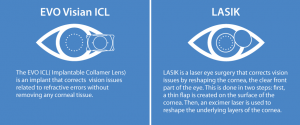-
Summer Savings: Save 20% On LASIK , Find More
*Must mention this promotion and be treated in August of 2024 to qualify. 20% off standard price of Wavelight procedure. Cannot be combined with any other offers.
EVO ICL VS. LASIK
When it comes to choosing a solution for your vision problems, you want to make sure you are making an educated decision that will be best for you and your eyes. You may have heard of a relatively new procedure known as EVO ICL, which is an alternative to LASIK. This article will clearly define both surgeries and break down their differences so you can make the best decision for your vision.
What is EVO ICL?
EVO ICL surgery is a type of refractive surgery that can be thought of as the addition of special permanent “contact” lenses into your eye. These lenses are called Implantable Collamer Lenses (ICL), and they are thinner and smaller than the average contact lens. The lens is inserted by a doctor into the interior of the eye, typically behind your iris and in front of your eye’s natural lens. In the center of the ICL lens is a hole to assist the flow of fluid around the lens and iris. This lens is permanent and will not need to be removed or cleaned like a regular contact lens.

LASIK VS. EVO ICL?
Unlike the EVO ICL surgery which requires an incision to be made in the eye and the insertion of a lens, LASIK takes place entirely on the cornea, the transparent, front part of the eye. LASIK reshapes the cornea, changing its shape (curvature), thus providing new vision. Before the LASIK procedure begins, anesthetic numbing drops are applied to your eyes. Once your eyes are completely numbed, your LASIK surgeon will use a laser to create a thin, hinged corneal flap, then gently fold the flap back to expose the cornea. A computer-controlled laser then emits pulses of light to reshape the cornea to your individual vision correction needs. The corneal flap is then laid back over the treated area of the cornea and begins to heal immediately. The flap is held in place through natural suction, so there is no need for sutures. The lasers used during laser vision correction procedures are incredibly precise in the reshaping of the cornea to correct the patient’s vision.
Risks Associated with EVO ICL
STAAR Surgical, a leading manufacturer of ICL implants, reports the following risks associated with EVO ICL lenses:
Endothelial Cell Loss
The cornea’s health is maintained by a thin layer of cells called endothelial cells, which regulate corneal hydration by pumping water out of it. Normally, these cells naturally decrease in number with age. However, following various types of eye surgery, including EVO ICL, there is a risk of additional endothelial cell loss beyond the normal rate. Excessive loss of these cells can lead to corneal cloudiness, which may result in decreased vision. STAAR Surgical reports that the “amount of loss can vary, but if loss reaches a critical level, there could be a buildup of fluid or swelling of the cornea (corneal edema). Corneal edema may require that your cornea be removed and replaced (corneal transplantation).”
Cataract Formation
Cataracts, characterized by clouding of the crystalline lens inside the eye, can decrease vision. Placing EVO ICL lenses near the crystalline lens increases the risk of cataract development, especially in older patients with higher levels of nearsightedness before surgery.
Increased Intraocular Pressure (IOP)
The placement of the EVO ICL lens inside the eye can result in an early increase in intraocular pressure (IOP). This is often caused by residual viscoelastic, a substance used during the surgery. In some cases, it may be due to blockage of fluid flow within the eye, requiring additional surgical intervention. The long-term risks associated with elevated intraocular pressure and other potential complications remain largely unknown.
Additional Risks
Beyond the aforementioned risks, STAAR Surgical also notes that EVO ICL surgery may be associated with additional potential complications, including:
- Astigmatism: Patients may experience an increase in focusing error (astigmatism) following the surgery.
- Pupillary Block Glaucoma: Blockage of fluid flow within the eye can lead to pupillary block glaucoma, characterized by elevated intraocular pressure. This condition can be a serious threat to vision.
- Unequal Pupil Size: Anisocoria, a condition where pupils are of unequal size, is another potential complication.
- Scar Tissue Formation: Scar tissue may develop at the outer edges of the front chamber of the eye, a condition known as peripheral anterior synechiae.
In addition, EVO has not been FDA-approved for the correction of farsightedness like LASIK has. Therefore, if you struggle seeing things that are up close, you are likely disqualified from being treated by EVO ICL.
So… which should I choose?
While EVO ICL is a newer procedure that shows exciting progression in the vision-correction field, it comes with its risks. While LASIK offers significant benefits in terms of vision correction, it also presents its own associated risks, These may include dry eyes, glare, halos, and the potential need for enhancement surgeries.
To determine the most appropriate treatment for your specific needs, you can begin with a LASIK consultation conducted by a qualified LASIK specialist.
At LasikPlus, we offer free consultations to see if you are a candidate. If you are, we would love to help you consider options including a traditional LASIK. If you aren’t a candidate, you can talk to our doctors about alternative options, which may include EVO ICL.
YOU MIGHT ALSO LIKE...
VISION CENTERS NEAR ME
Enter your zip code, city, or a doctor name below to find a vision center.
Find out if LASIK is right for you
Congratulations!
Your vision issues can most likely be corrected with a LASIK procedure. Schedule a free consultation today.
Answer 5 simple questions to see if you are a candidate
What is your age group?
Do you wear...
With corrective lenses, do you have...
Have you ever been told that you have astigmatism?
Have you ever been told that you have dry eyes?
Request an Information Kit
Learn about your surgeon, the latest advanced technology, procedures, options and benefits, financing options, and what to expect from your LASIKPlus experience.









